Unpacking the new EU F-Gas regulation
26th January 2024
Introduction
In January 2024 the European Parliament overwhelmingly voted to approve amendments to the EU F-Gas regulation, which will phase out the use of HFCs for cooling and heating by 2050. The new legislation will introduce stricter bans and controls on fluorinated gas use in various applications, but some industry bodies are concerned about the lack of time to adapt and ensure engineers are skilled to handle alternative refrigerants. The proposed changes now require approval by members of the European Council. The vote could take place as early as the end of January.
Now seems like a good time to review and analyse the details of these proposed changes to the EU F-Gas regulation to show how this could shape the future of the European industry. Its also important to review how this monumental change in European legislation will affect the UK and beyond. After the UK left the European Union on the 1st January 2021 the 2014 F-gas regulations were incorporated into to UK law. However further revisions by the EU may not mandated to be incorporated into UK law. A separate review in the UK being conducted by the Department for Environment, Food and Rural Affairs (DEFRA) is currently in charge of updating the UK revisions to F-Gas which is expected during 2024.
In this article, we will explore the historical context surrounding the legislation and subsequently delve into the key highlights outlined in the recently proposed update to EU F-Gas regulation. Moreover, we will undertake an analysis of the challenges that various industries will encounter while striving to meet the demanding timelines prescribed by this legislation. Additionally, we will endeavour to anticipate the far-reaching implications that this European Union regulation is likely to impose on the United Kingdom and other nations globally.
Background
The 2014 EU F-Gas regulation replaced the 2006 regulation, strengthening all the 2006 requirements and introducing a number of important new measures.
The 2014 legislation aims to progressively phase out the use of high global warming potential (GWP) gases in various sectors, such as refrigeration and air conditioning, foam blowing, and fire protection systems. It controls the use of F-gases and F-gas based systems though restrictions on production, import, installation, and maintenance, whilst also enforcing the proper handling, containment, and reporting. The regulations also indirectly encourage the adoption and development of alternative and more environmentally friendly solutions.
A crucial aspect of the 2014 regulation is the introduction of the phase down in the supply of HFCs within the EU market. This table shows how the phase down process occurred and the impact that this will have on the current market for HFCs. The phase down will lead to a 79% cut to the 2009-12 baseline levels of HFCs by 2030. The European F-Gas legislation serves as a crucial pillar in the EU’s commitment to mitigating climate change and transitioning to a low-carbon economy.
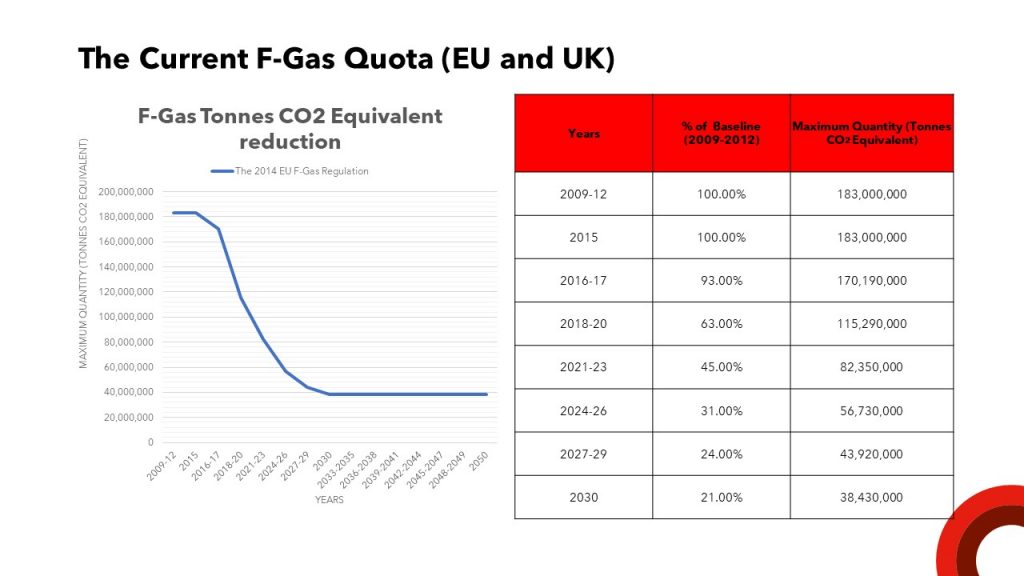
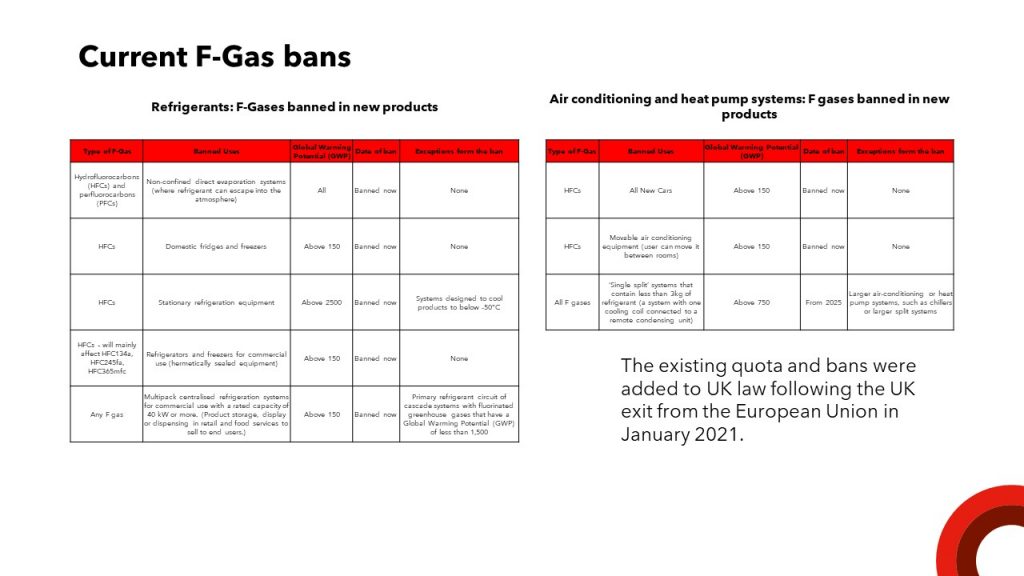
Unpacking the new EU F-Gas legislation
The provisional deal to revise the EU F-gas regulation was agreed by the European Parliament and Council on October 5. It will see targeted bans on the use of F-Gases (Including HFCs and HFOs), and a complete phase out of all F-Gases by 2050. The first reading took place on the 16th January in Strasbourg. This involved the proposal being put to a vote in the European Parliament. The vote was overwhelmingly passed 581 votes cast, 457 were in favour with only 92 against and 32 abstentions.
The next step requires the proposed changes to be approval by members of the European Council. The vote could take place as early as the end of January. Once this process is complete the new F-gas regulation will be published in the Official Journal of the European Union and is widely expected to enter into force in spring 2024. Since Brexit the new EU updates to F-Gas will not automatically apply to the UK , however the implications to the UK are explored later in the article.
The proposed new EU F-Gas regulation will update and strengthen the 2014 EU F-Gas regulation. The next big reduction in the quota, originally scheduled for 1 January 2024 has now been put back to 1st January 2025. The new proposed legislation offers a slightly more relaxed phase down in the early years than the original European Commission proposals, which sought a near 50% phased down from current quota levels next year to 41.7MtCO2e. However, the new proposals provide for a slightly higher allowance of 42.9MtCO2 . The phase down will ultimately lead to a complete ban of all F-gas refrigerants by 2050, through the reduction in HFC production writes and F-Gas quota system.

In addition to the stricter reduction in F-Gas quota, the new EU F-Gas regulation will also introduce targeted bans on new equipment and maintenance of new equipment containing high GWP F-gases. These bans cover all aspects of refrigeration and HVAC including Stationary Refrigeration Equipment, service and Maintenance, self-contained and split AC and heat pump equipment, and chillers. Full details of the bans are highlighted in the bans below:-
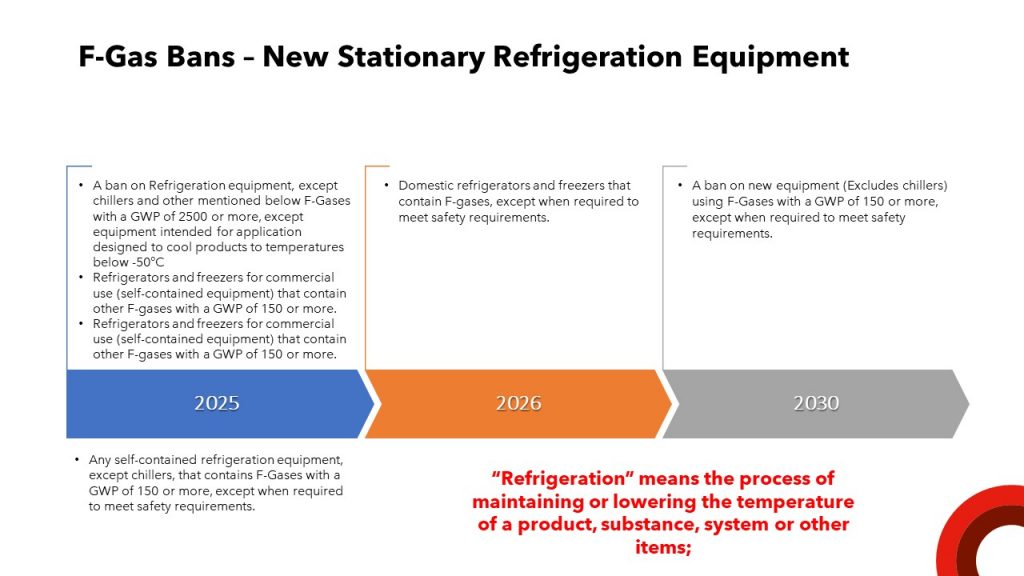

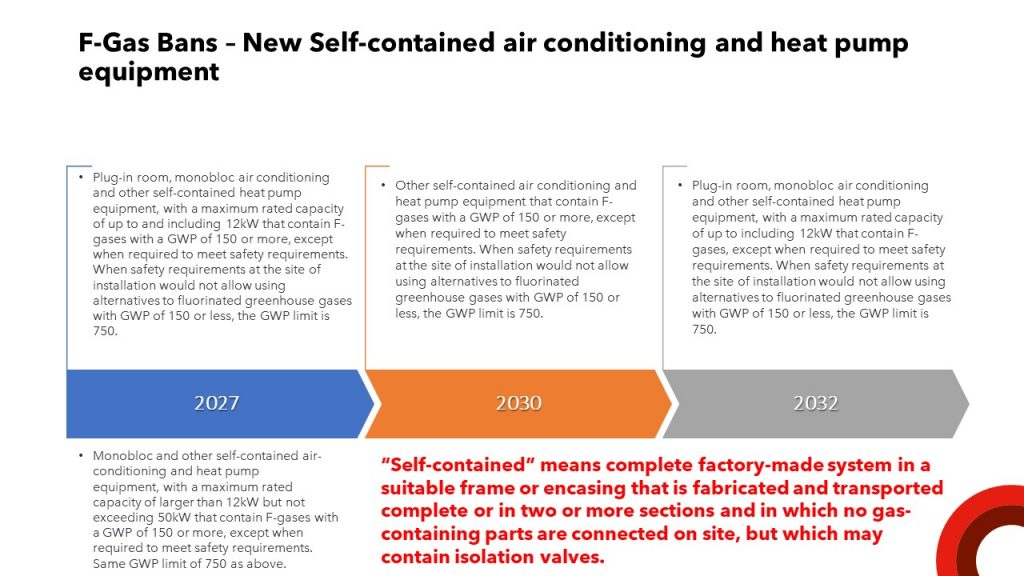
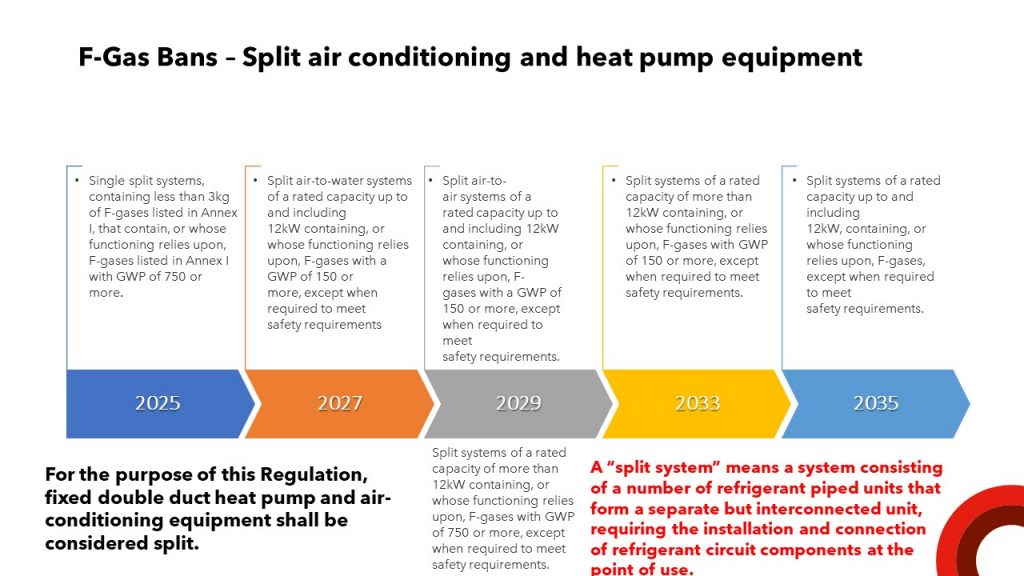
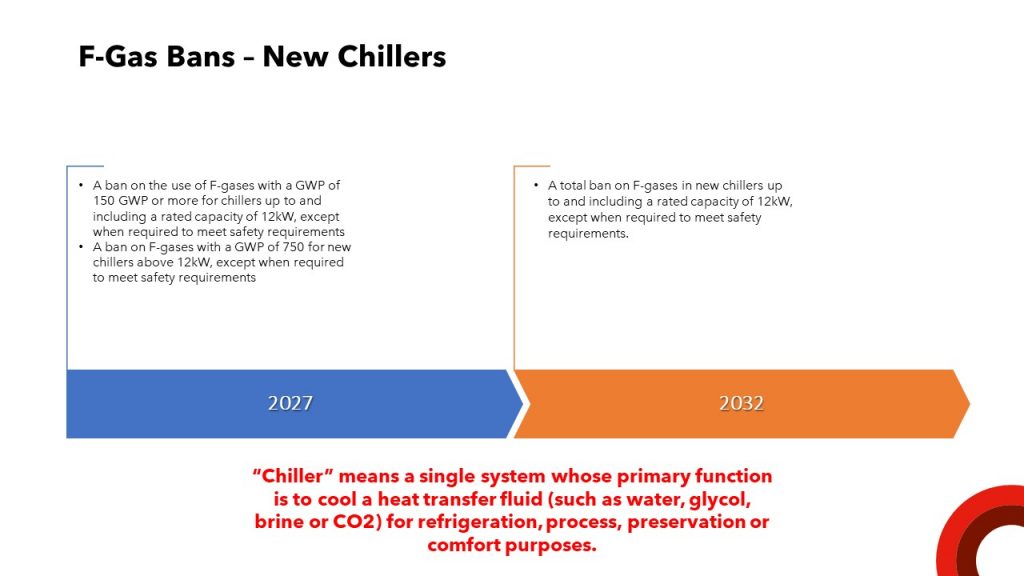
Exemptions
However, as you can see from many of these bans they are limited by the exemption of when required to meet safety requirements.
This is defined in the draft legislation as “Safety requirements” means requirements on the safety of using fluorinated greenhouse gases and natural refrigerants or products and equipment containing or relying on them, prohibiting the use of a certain fluorinated greenhouse gases or their alternatives, including when contained in product or equipment at a specific place of intended utilisation due to site and application specificities that are either:
- Set out in Union or national law; or
- Set out in a non-legally binding act containing technical documentation or standards that have to be applied to ensure safety at the specific location, provided that they are in line with relevant Union or national law
Are these a necessary inclusion or will they dilute the teeth and intended sprit of the legislation? Are these specific enough or will installers always state safety requirements as an issue to avoid moving to lower GWP alternatives? Only time will tell if this has the intended effect. However, this clause leads on nicely to the next section on industry challenges to the new legislation.
Industry challenges
One significant challenge that industry has highlighted is the requirement for engineers to acquire the necessary skills to handle alternative refrigerant gases characterized by higher flammability, toxicity, or pressure levels. This increase in training poses a considerable obstacle to the industry who is already struggling to attract enough skilled engineers. The issue of training and how the wider Heating, Ventilation, Air Conditioning, and Refrigeration (HVACR) industry must adjust to the anticipated changes in the EU F-Gas Regulation is a major topic of discussion and will remain so for the foreseeable future.
Trade bodies representing the refrigeration, air conditioning, and heat pump (RACHP) sector in Europe have expressed concerns regarding the proposes EU updates to the F-Gas agreement and its subsequent reforms. While supportive of the overall goals to transition to low GWP refrigerants, these trade bodies worry about the industry’s ability to adapt within the stringent legislative timeframe. They argue that training engineers to work with alternative refrigerants, which may have higher levels of flammability, toxicity, or pressure, poses a significant challenge.
There is also a concern about the application of flammable refrigerants such as A2L’s or hydrocarbons in domestic and commercial setting for AC, Heat pumps and also refrigeration. A key aspect of the challenges posed using A2L refrigerants, which possess a lower level of flammability compared to A3 gases, lies in their distinct handling requirements. The handling and management of A2L refrigerants present unique hurdles that must be carefully addressed to ensure the safe and efficient provision of solutions such as split air conditioning systems by contractors or sub-contractors.
To tackle these challenges effectively, the HVACR industry must prioritize comprehensive training programs that cover the unique characteristics and handling procedures of A2L refrigerants. Installers need to be educated on identifying, mitigating, and responding to specific risks associated with these refrigerants. This knowledge will enable them to confidently provide solutions like split air conditioning systems that incorporate A2L refrigerants while ensuring compliance with safety regulations. Moreover, manufacturers and suppliers have a vital role to play in facilitating this transition.
Finally, there is also a concern about the investment and innovation required by OEM’s due to the timeline required in to support this transition to lower GWP refrigerants. Typical development cycles for AC and heat pump products can be 7-10 years, however due to the tight timelines of the bans from the new legislation these typical times lines are not achievable. Therefore, OEM’s may not be able bale to develop the required products in time to meet deadlines or worse may rush to develop products that are put onto the market without the correct due diligence.
Implications for the UK
The updated EU F-Gas Legislation has important implications for the United Kingdom following its exit from the European Union. While there is no legal obligation for the UK to follow new European F-Gas legislation, the Department for Environment, Food and Rural Affairs (DEFRA), responsible for F-Gas regulations, has expressed its intention to maintain alignment with the European regulations. However, DEFRA may choose to adopt a more stringent approach than the European legislation, potentially including mandatory training on handling flammable refrigerants. Which will go some way to address some of the challenges raised by the industry.
The process for finalising the UK F-Gas legislation is expected to involve several steps. A consultation period has been put in place from December 2023 to February 2024 will enable stakeholders to provide feedback and contribute to the development of the legislation. DEFRA aims to finalise the legislation between April and June 2024, after which it will be presented to Parliament in June 2024 for further scrutiny and potential amendments. The primary F-Gas Legislation is set to be implemented from January 2025, with the secondary legislation being rolled out from that point onwards.
By aligning with the new EU F-Gas Legislation, the UK aims to ensure a continuation of efforts to reduce greenhouse gas emissions and improve the environmental performance of the refrigeration and air conditioning sector. However, the potential for a more stringent approach on training requirements suggests the UK’s commitment to prioritizing safety and expertise in handling flammable refrigerants, underlining the importance of maintaining high standards in the HVACR industry.
The finalised UK F-Gas legislation will provide guidance and regulations for the use, handling, and disposal of fluorinated gases, with a focus on mitigating their environmental impact. It is expected that the legislation will establish clear guidelines for industry professionals, including contractors, engineers, and technicians, regarding the safe handling and maintenance of refrigeration and air conditioning systems. This will contribute to the ongoing efforts to reduce greenhouse gas emissions and prevent refrigerant leaks that can contribute to global warming.
Overall, while the UK is not legally bound to adopt the updated EU F-Gas Legislation, DEFRA’s signalled commitment to aligning with European regulations signals a desire to maintain environmental standards and collaborate in reducing greenhouse gas emissions. From a cynical perspective there is also a concern that the UK lacks the required resources or motivation to deviate from the EU F-Gas approach. However by potentially implementing stricter training requirements, the UK aims to lead the way on safe handling and use of refrigerants, prioritizing both environmental concerns and safety.
Global implications
The updated EU F-Gas Legislation and its implications extend beyond the borders of the European Union, impacting countries worldwide, including the United States and Canada. While again these countries are not legally bound to follow European regulations, the EU’s stance on F-Gas emissions has influenced global efforts to reduce fluorinated greenhouse gas (F-Gas) emissions and promote environmental sustainability in the HVACR industry.
The EU’s stringent regulations have set a precedent and created pressure for other countries to take similar actions to tackle F-Gas emissions. As a result, countries outside the EU, such as the United States and Canada, have implemented their own measures to regulate F-Gas emissions and encourage the use of low Global Warming Potential (GWP) refrigerants. These measures aim to align with international agreements, such as the Kigali Amendment to the Montreal Protocol, which aims to phase down the use of high GWP refrigerants globally.
In the United States, the Environmental Protection Agency (EPA) has established regulations under the Significant New Alternatives Policy (SNAP) program to limit the use of high GWP refrigerants in certain applications. These regulations promote the adoption of low GWP refrigerants and energy-efficient technologies in line with global environmental objectives. The EPA also established in 2023 a final rule to implement a to phase down the use on the use of HFC refrigerants. Which amounts to a 40% reduction below historic levels from 2024 through 2028.
Similarly, Canada has implemented the Ozone-depleting Substances and Halocarbon Alternatives Regulations under the Canadian Environmental Protection Act (CEPA). These regulations control the import, manufacture, and use of substances with ozone-depleting potential, including regulations specific to hydrofluorocarbons (HFCs) with high GWP.
Both the United States and Canada have been actively involved at international forums to address F-Gas emissions. They have participated in discussions surrounding the Kigali Amendment and have shown commitment to transitioning to more environmentally friendly refrigerants. These actions reflect the global consensus to reduce the use of high GWP refrigerants in various cooling and refrigeration applications. The actions of the EU in implemented stricter F-Gas restrictions and phase downs will have impacts across the globe with other countries facing pressure to follow suit.
Furthermore, the influence of the EU F-Gas Legislation reaches beyond national borders through the global supply chain. Manufacturers and suppliers in the HVACR industry often produce equipment compliant with international standards, including those set by the EU. As a result, the availability and use of low GWP refrigerants are increasingly widespread globally, driven in part by demand generated by the EU regulations.
In summary, while the EU F-Gas Legislation is not directly binding on other nations countries however, its regulatory efforts to reduce F-Gas emissions have influenced global initiatives and spurred action in other parts of the world. These countries have developed their own regulations and participated in international agreements to address high GWP refrigerants, emphasizing the global commitment towards environmental sustainability and the reduction of F-Gas emissions in the HVACR industry. Will the EU continue to lead the way in F-Gas emission reduction, or will another nation take up the challenge and impose even stricter legislation?
Conclusion
In conclusion, the upcoming approval of the updated European F-Gas legislation expected in Spring 2024 signifies a major step towards addressing the environmental concerns posed by F-Gas refrigerants. With the strong likelihood that the UK will also adopt these updated regulations, it is important for businesses to prepare and adapt accordingly.
The new legislation will result in a reduction in production and reduced quotas for F-Gas refrigerants, leading to an inevitable increase in prices for higher GWP refrigerants. To mitigate the potential cost implications, it is crucial to reclaim and retain all F-Gas refrigerants within your estate for future utilisation. It’s important to recognise refrigerants as valuable commodities, and noting how their significance will only grow in the future.
Furthermore, it is important to acknowledge that HFC refrigerants have a limited life expectancy and will face increasing restrictions under the F-Gas legislation, possibly even under the REACH Regulations. To effectively manage this, businesses need to develop a comprehensive strategy to remove these refrigerants from their estates.
It’s also clear that the impact of the updated EU F-Gas Legislation extends far beyond the borders of the European Union. With countries worldwide, including the United States and Canada, taking notice and implementing their own measures to address F-Gas emissions. While not legally bound to comply with European regulations, these countries recognize the importance of reducing fluorinated greenhouse gas emissions and have implemented regulations aligned with international agreements. The influence of the EU regulations can be seen throughout the global supply chain as manufacturers and suppliers conform to international standards, including those set by the EU
By staying proactive and implementing appropriate measures, businesses can comply with the updated regulations, reduce their impact on the environment, and ensure the long-term sustainability of their operations. Embracing sustainable alternatives and responsibly managing refrigerants will not only benefit the environment but also contribute to a more efficient and cost-effective approach to heating and cooling systems.
If you need any advice or support with navigating the complexities of the F-Gas legislation reach out to WAVE here.


